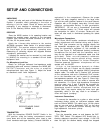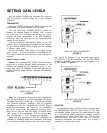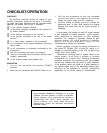
through the use of linear-phase IF filtering and high-
quality audio circuitry. A high signal-to-noise ratio and
wide dynamic range are necessary for noise-free, op-
timum performance. The Shure wireless uses com-
plementary compression and expansion circuitry in the
transmitter and receiver (companding) as well as pre-and
de-emphasis to achieve a maximum S/N ratio of 98 dB
A-weighted.
With the Transmitter Off.....
When the wireless microphone transmitter is turned
off, the receiver can still receive transmissions from
other sources. However, since the Shure system
operates in the 150-216 MHz band, it’s not susceptible to
interference from radio wave skip, or CB or FM broad-
cast transmissions. The frequencies chosen for use in
the Shure system are computer-selected for minimum in-
terference, but it’s almost impossible to guarantee a
“clear channel” at any location or at any time. (For in-
stance, care must be taken to avoid wireless microphone
operating frequencies that are within the bandwidth of
locally operating TV channels 7 through 13.)
If the wireless system is to be in a permanent location,
it should operate without interference until someone
else in the vicinity starts using that frequency. But if the
system is to be used in different locations (i.e., “on the
road”), occasional frequency conflicts are inevitable. In
any case, if the wireless microphone is not in use, the
audio mixer gain should be turned down just as with a
wired microphone. If the mixer controls are not accessi-
ble, turn the receiver off when the transmitter is not in
use to prevent unwanted signal pickup. If the system
must be left on and mixer controls are not accessible,
the transmitter should be left on to prevent outside in-
terference pickup.
1.
2.
3.
On Feedback.....
The use of a wireless microphone doesn’t eliminate
the possibility of annoying feedback. Feedback control
is generally achieved by careful placement of the
speakers relative to the microphone, minimum levels
necessary for the desired sound, good microphone
technique, and proper equalization of the sound system.
Transmitter Range.....
The FCC-required low power output of the transmitter
means that its distance from the receiver should be kept
as short as possible. Up to 150 meters (500 feet) should
be considered a maximum, although 300-meter
(1000-foot) or greater operation is often accomplished.
Reflections, obstacles and interference in a given in-
stallation will dictate the system’s limits.
Other wireless systems that claim greater distance
and flexibility in their operation neglect to state that
each installation must be considered separately. A wide
variance exists between best- and worst-case condi-
tions.
System Power.....
The receiver operates from power supplied by a
separate ac power converter provided with the system.
In addition to 120-volt operation with the power con-
verter, the receiver can be operated from any well-filtered
source of 13.5 Vdc at 200 mA. An optional 220-240-volt
power converter (WA350) is also available.
The transmitter operates from any 9-volt alkaline
transistor-radio-type battery (Duracell MN1604 is recom-
mended). Typical battery life is 8 hours. Inexpensive
carbon-zinc batteries are not recommended; their ex-
tremely short life-about an hour- restricts them to
emergency use only. If nickel-cadmium rechargeable
batteries are used, they must be 8.4-volt (not 7.2-volt)
types. The lower-voltage batteries will not provide proper
transmitter function.
What Else is Needed.....
In order to make this wireless microphone system
operational, the following is needed:
A battery for the transmitter.
A microphone for the transmitter-either one design-
ed specifically for the wireless transmitter (such as
the Shure WL83),
or most low-impedance
microphones (dynamic, ribbon or condenser) with a
microphone adapter cable (WA310). But if the
wireless system is to be connected to the electrical
output of a musical instrument instead of a
microphone, a transmitter instrument cable (WA300)
must be used.
A receiver-to-mixer cable, with a female XLR connec-
tor on one end (for the receiver output) and whatever
connector is needed for the mixer microphone input
on the other.
Optional accessories, useful but not required, are
described in this manual.
*IMPORTANT: Other microphones specified as being for wireless microphone use
are probably not wired for use in Shure wireless systems. Condenser microphones
with phantom-powered preamp circuits - Shure SM85, SM87, etc. - will not operate
with this transmitter.
4


















